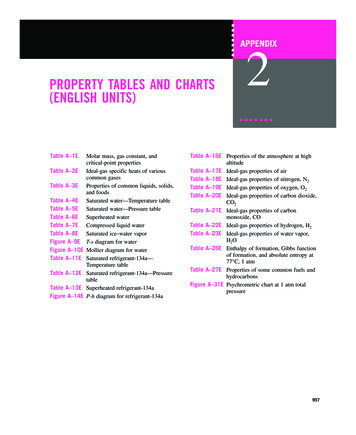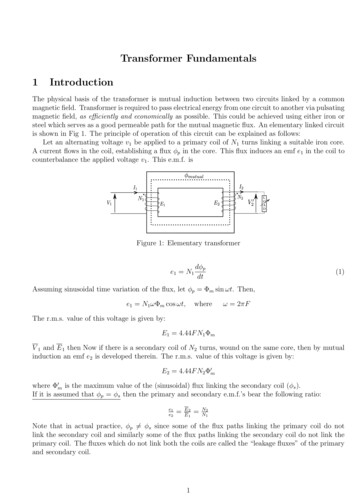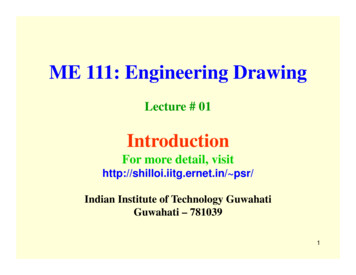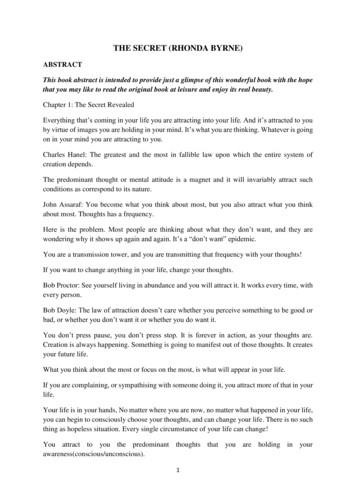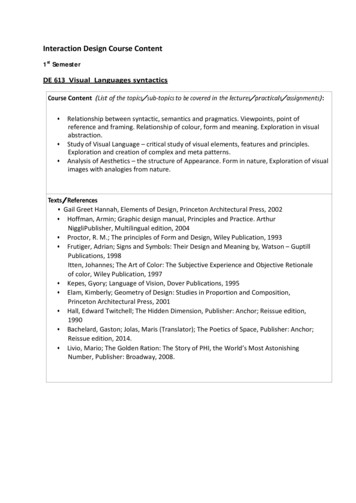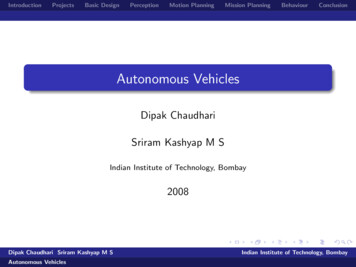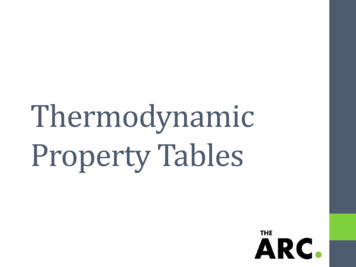
Transcription
ThermodynamicProperty Tables
Property Tables If you have 2 properties,you can find the othersusing thethermodynamic propertytables. There are separate propertytables for saturatedmixtures, subcooled liquids,superheated vapors, andideal gases. E.g. If you have pressureand temperature forsteam, you can find it’sspecific volume,enthalpy, internalenergy, and entropy. Thermodynamic propertytables can be found in theback of your textbook orvarious places online.
Interpolation Interpolation allows you to findvalues that are in between whatthe table provides The interpolation factor isconsistent throughout the tablefor each individual state and isgiven by:a v vlv h vlwhere v is the actual (given)property value, vl is the lowervalue on the chart, and vh is thehigher value on the chart. E.g. If a subcooled liquid has aknown pressure of 3.0 kPa, and atemperature of 27 C, but the onlytemperatures listed on the chartare 20 C and 30 C, then theinterpolation factor is:a T TlT h Tl 27 2030 20 0 .7 Other properties are found by:v vl a * (v h vl )u u l a * (u h u l )h hl a * ( h h hl )
Saturated Property Tables Between a liquid and avapor – contains both. Quality (0 x 1)determines properties. A quality of 0 is a saturatedliquid. A quality of 1 is a saturatedvapor. If given a temperature anda pressure, the quality isneeded to determine itsother properties. To determine whether ornot a substance is asaturated mixture from thepressure and temperature,look at the pressure charts. If the temperature of theactual substance is higherthan the saturatedtemperature, it’s asuperheated vapor. If it’s lower, it’s a subcooledliquid. If the two temperaturesare equal, it is a saturatedmixture.
Temperature Tables Use the temperature table forwhen you are given thetemperature of a saturatedmixture Use the temperature and thequality to determine theother properties E.g. For steam at 70 C and aquality of 0.25, the specificvolume is:v v f x * (v g v f )v . 00102 . 25 * ( 5 . 0395 . 00102 )v 1 . 2606 m3kg
Temperature Tables If given temperature andanother property, find thequality by reversing theprocess. E.g. For steam at 70 C and aspecific energy of 1000kJ/kg:x x u ufug u f1000 293 . 032468 . 9 293 . 03x 0 . 325 The pressure for anysaturated mixture is thepressure at that temperature
Pressure Tables Use the pressure table forwhen you are given thepressure of a saturated mixture Like the temperature table, usethe pressure and the quality todetermine the other properties E.g. For R134a at 300kPa and aquality of 0.25, the specificvolume is:v v f x * (v g v f )v . 0007737 . 25 * (. 0677 . 0007737 )v . 0175 m3kg
Superheated Gas Tables Used for temperatures higherthan the saturation temperatureat a given pressure. Any two properties allow you tofind all other properties at thatstate. E.g. For superheated R744 at 100 and h 558 kJ/kg, the pressure is:a a h hlh h hl558 554 . 73560 . 97 554 . 73 0 . 524P Pl a * ( Ph Pl )P 3 . 0 . 524 * ( 2 . 0 3 . 0 )P 2 . 48 MPa
Subcooled Liquid Tables Used for temperatures lowerthan the saturation temperatureat a given pressure Any two properties allow you tofind all other properties at thatstate. E.g. For subcooled water at240 C and u 1027 KJ/kg, thepressure is:a a u uluh ul1027 1026 . 11031 . 6 1026 . 1 0 . 164P Pl a * ( Ph Pl )P 10 . 0 . 164 * ( 5 . 0 10 . 0 )P 9 . 18 MPa
ReferencesFundamentals of Engineering Thermodynamics, Moran and Shapiro,Ch.3Thermodynamics – Theory http://ecourses.ou.edu/cgibin/ebook.cgi?doc &topic th&chap sec 02.3&page theorySteam Tables – ynamics/steam tables.htmGuide to Using the Two-Phase Property Tableshttp://abata.sdsmt.edu/pdf %20Property%20Tables.pdfPrepared by Veronica Hannink
steam, you can find it’s specific volume, enthalpy, internal energy, and entropy. There are separate property tables for saturated mixtures, subcooled liquids, superheated vapors, and ideal gases. Thermodynamic property tables can be found in the back of your textbook or various places online. Interpolation Interpolation allows you to find values that are in between what the table .

